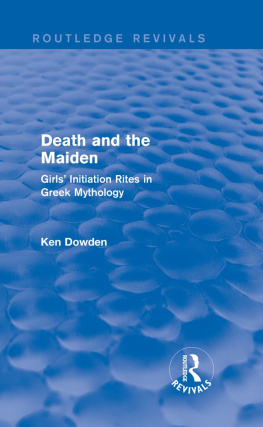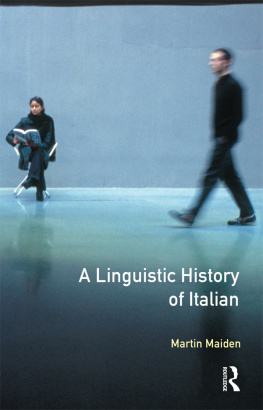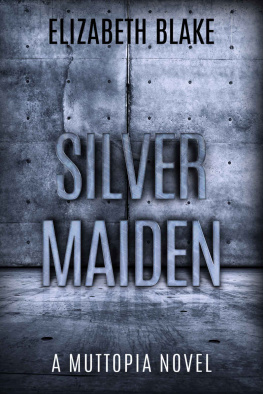Killing the Indian Maiden
Killing
the
Indian
Maiden
Images of
Native American Women
in Film
M. Elise Marubbio

Publication of this volume was made possible in part by a grant from the National Endowment for the Humanities.
Copyright 2006 by The University Press of Kentucky
Paperback edition 2009
Scholarly publisher for the Commonwealth, serving Bellarmine University, Berea College, Centre College of Kentucky, Eastern Kentucky University, The Filson Historical Society, Georgetown College, Kentucky Historical Society, Kentucky State University, Morehead State University, Murray State University, Northern Kentucky University, Transylvania University, University of Kentucky, University of Louisville, and Western Kentucky University.
All rights reserved.
Editorial and Sales Offices: The University Press of Kentucky
663 South Limestone Street, Lexington, Kentucky 40508-4008
www.kentuckypress.com
13 12 11 10 09 5 4 3 2 1
The Library of Congress has catalogued the hardcover edition as follows:
Marubbio, M. Elise, 1963
Killing the Indian maiden : images of Native American women in film / M.
Elise Marubbio.
p. cm.
Filmography: p.
Includes bibliographical references and index.
ISBN-13: 978-0-8131-2414-8 (hardcover : alk. paper)
ISBN-10: 0-8131-2414-X (hardcover : alk. paper) 1. Indian women in motion pictures. I. Title.
PN1995.9.I48M37 2006
791.43652208997--dc22 2006020629
ISBN-13: 978-0-8131-9238-3 (pbk. : alk. paper)
This book is printed on acid-free recycled paper meeting the requirements of the American National Standard for Permanence in Paper for Printed Library Materials.

Manufactured in the United States of America.

| Member of the Association of
American University Presses |
To my parents, A. Thomas and M. Lavonne Marubbio:
your own passion for learning, art, social justice,
and critical thinking have formed me
and inform this work
thank you.
Contents
Illustrations
Preface
Killing the Indian Maiden: Images of Native American Women in Film analyzes a particular figure in Hollywood cinema, which I term the Celluloid Maiden, that depicts a young Native American woman who enables, helps, loves, or aligns herself with a white European American colonizer and dies as a result of that choice. This work brings together my research into the Hollywood film industrys continual use of this figure from the silent period to the present in thirty-four A-list films. The longevity and complexity of the Celluloid Maiden figure came into focus as I combed through films from the silent period through the 1990s, Production Code files from the Academy of Motion Picture Arts and Sciences collection, film reviews, scholarly analyses, and theoretical studies on film, particularly the western.
The overall implications of a century of confining Native American women in film to such a sacrificial role can be understood only through the application of a combination of methods. Thus Killing the Indian Maiden addresses the films as social narratives and politically inspired works of art that inform us about our societys fears, desires, politics, conflicts, and structures of power. Most important, I consider the artistry and visual machinations of film in relation to the political message presented to the viewer. How one reads, remembers, and reacts to a film depends on how it is constructed as a visual product and how it is promoted. These elements inform how we receive and perceive it as a visual text. The cinematic beauty of a film can either overshadow or emphasize the very real racist and sexist agendas of the film narrative or iconography. To facilitate the process of reading these films as cultural texts, I utilize a multidisciplinary framework that include theories of nationalism, colonialism, and power and film studies approaches to gender, race, and Native Americans in the media. This work combines these theories and approaches with a historical analysis of the social atmosphere and political attitude toward Native Americans and women at moments relevant to the individual films under analysis.
To help elucidate the trends in depicting the Celluloid Maiden and the social attitudes of the various eras of the figures history, Killing the Indian Maiden is divided into three sections: The Celluloid Princess, The Sexualized Maiden, and The Hybrid Celluloid Maiden. Each section is further divided into two chapters that focus on particular eras of film representationsthe Princess of the silent period and the 1950s, the Sexualized Maiden of the 1940s and the 1950s1960s, and the hybrid figure of the 1970s and the 1990s. This framework highlights the breadth of the overall trends that emerge while also providing depth.
Interest in the role and image of Native Americans in film history has escalated over the last thirty years. However, very little scholarship exists on the Native American woman in film, in large part because of the cultural assumptions that primary characters in westerns and action films in general must be male, and because Indian often seems to be interpreted as a masculine term. The most comprehensive works on film have dealt with Pocahontas, but not with the Celluloid Maiden extension of that historical image. Likewise, few analyses concentrate on the particular forms of racism constituted by Native Americanwhite relations in U.S. history. Much of the work in critical race theory on Hollywood films focuses on the specific dynamics of black-white racial formations. Importantly, no in-depth work exists on the Celluloid Maiden theme and its social ramifications. Thus I see a great need to explore the social and political implications surrounding Hollywoods Celluloid Maiden, especially in light of the continuing reproduction in film of nationalist and racist agendas through themes of manifest destiny and antimiscegenation.
Killing the Indian Maidens significance lies in its dedication to understanding the ways in which our culture utilizes racialized, gendered, and sexualized bodies, especially female bodies, as sites for inscribing difference. I am interested in the complex web of power relations that exists in the cultural arena informing film images. Cinema, as a white maledominated industry, and film, as a voyeuristic medium, offer a lens through which to analyze the psychological and sociological structures created through representations of subservient, simplistic, self-destructive Others. I am concerned with how the historical and filmic relationship between whites and Native Americans in general, which informs this image of Native American women specifically, creates intercultural boundaries that continually reinforce social, racial, and gendered difference.
This book began as my love affair with film representation and blossomed during my graduate training at the University of Arizona in American Indian studies and cultural studies. I pursued my own visual approach to discussing film representations of Native Americans, nurtured by mentors, teachers, and friends who believed that I could apply my training as a visual artist to the ways in which I read film. In particular, I extend my deepest gratitude to Tom Holm, Susan White, Mary Beth Haralovich, and Daniel Bernardi for their dedication to this project and their invaluable feedback. Their combined efforts serve as my model for teaching, mentoring, and scholarship. I owe a special thanks to Tom Holm for his years of friendship, advising, insight, and prodding. Toms guidance and belief in my abilities prompted this research, and his spirit emerges on every page of this book. Without him, this research would have awaited another scholar; this book would still be a manuscript on my desk. Similarly, Susan White has proven a dear friend and an invaluable teacher. The cultivation of my visual approach to reading film and her attention to my writing craft attest to her skill as a teacher. She has helped me navigate the difficulties of harnessing artistic vision and honing it with academic methodology. Mary Beth Haralovich, who donned her cape and swept into this project when I desperately needed a film historians perspective, has my undying gratitude. Daniel Bernardis work on race and Whiteness informs this book and emerges as the grounding that helps me understand the trends I see across the span of film history. His advice to me at key moments in the writing process kept me going and owning my own work. In addition, Annette Kolodnys work on the feminization of the landscape helped me connect the pre-American images of Native women and the landscape to the film industrys use of the Celluloid Maiden trope.
Next page












